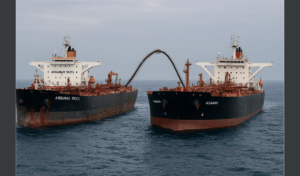Russian Oil Tanker Blocked: 2 Shocking Moves Traders Used to Bypass India’s Ban
A Russian oil tanker, Andaman Skies, carrying nearly 800,000 barrels of crude, was blocked from docking at India’s Vadinar port due to its age and lack of proper safety certification. Built over 20 years ago, the ship failed to meet Indian maritime rules requiring updated inspection credentials. Instead of turning back, the oil is being transferred mid-sea to other vessels, including the Ozanno and Sao Tome, part of the so-called “shadow fleet” that often helps sanctioned oil reach buyers.
The cargo originated near Murmansk and was bound for Indian Oil Corp. This workaround reflects how traders are increasingly relying on ship-to-ship transfers to navigate tightening Western sanctions. While both ships involved are under sanctions, India only enforces those imposed by the U.S. and UN, not the EU or UK. This legal loophole enables newer tankers like Ozanno to legally deliver the oil. As pressure mounts on Russian oil exports, these evasive methods are becoming more common, highlighting a growing challenge for global regulators.

Russian Oil Tanker Blocked: 2 Shocking Moves Traders Used to Bypass India’s Ban
A cargo of Russian crude oil that was blocked from entering an Indian port is now being transferred to another ship at sea, offering a glimpse into how oil traders are adapting to a tightening web of sanctions and maritime regulations.
The original vessel, a tanker named Andaman Skies, was prevented from docking in Mumbai due to its age—more than two decades old—and a lack of valid safety certification. Under Indian maritime law, ships older than 20 years must carry up-to-date inspection approvals from recognized international bodies. The Andaman Skies reportedly failed to meet this requirement, prompting Indian authorities to deny its entry.
Rather than sending the shipment back or risking penalties, the oil is now being offloaded from the Andaman Skies to another vessel, the Ozanno, through a ship-to-ship (STS) transfer. This method involves moving cargo between vessels while at sea and is commonly used by tankers operating in the so-called “shadow fleet”—a loosely regulated group of ships used to transport oil from sanctioned countries like Russia and Iran. These vessels often skirt conventional shipping norms and operate with limited oversight or insurance.
Shipping data shows that the Ozanno, built in 2008, is currently positioned alongside the Andaman Skies off the Indian coast. The shipment, nearly 800,000 barrels of crude oil, was originally loaded near Murmansk, Russia, and is now on course to reach the Indian Oil Corporation’s facility in Vadinar.
Although both the Andaman Skies and the Ozanno fall under Western sanctions, India maintains a selective approach to enforcement. It adheres to sanctions issued by the United States and the United Nations but does not recognize those from the European Union or the United Kingdom. This distinction allows the Ozanno—a younger, Indian-managed ship—to legally offload oil under Indian jurisdiction despite its sanctioned status elsewhere.
This incident highlights a broader trend in the global oil trade: exporters and shipping companies are increasingly turning to alternative routes and tactics to keep oil flowing. With mounting restrictions in place, workarounds like STS transfers are becoming more common—especially as countries such as India and China continue purchasing discounted Russian crude.
Reports also indicate that a second vessel, the Sao Tome, received part of the same cargo through a similar transfer. The crude originated from Lukoil, a Russian energy giant that has been relying on unconventional logistics to maintain exports since Western sanctions were imposed in response to the war in Ukraine.
India has risen to become Russia’s second-largest oil buyer, trailing only China. However, aging Russian tankers and ships linked to sanctioned entities are increasingly being turned away from Indian ports. According to Bloomberg, dozens of Russian-affiliated tankers are now sitting idle near Indian waters—an unusual situation not seen since 2017.
In response to Russia’s continued oil exports, the U.S. stepped up its enforcement in late 2024, targeting nearly 40 ships involved in moving sanctioned crude. This was followed by further penalties in early 2025 against Sovcomflot, Russia’s largest shipping firm, for violating the G7’s $60-per-barrel price cap. That cap was first introduced in December 2022 to curb Russian oil revenues while maintaining global supply.
Despite the sanctions and enforcement efforts, Russia has managed to sustain oil exports by leveraging its “ghost fleet”—a network of old, obscure vessels that operate outside traditional shipping channels. These ships often lack proper insurance, avoid standard tracking systems, and move cargo in secrecy, keeping trade alive in the face of escalating global restrictions.
You must be logged in to post a comment.